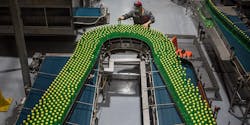For China Supply Chains, Backlogs, but ‘Things Are Looking Better’
For the first time since the coronavirus pandemic broke out, China has reported no new cases transmitted locally. I’m also seeing better times for Chinese factories and supply chains. This week my clients finally received shipments of lighting fixtures, gear boxes, tricycles, circuit boards and lawn mower engines.
In late February, President Xi Jingping made calls for people, factories and businesses to get back to work. “This is both a crisis and a big test for us,” said Xi. So, is the crisis over? Are Chinese employees back at work? Are factories running again?
“I think we are getting back to normal already,” said Kitty Han, a marketing manager for Cambi Environmental Technology Company in Beijing, a Norwegian-based waste management solutions provider and manufacturer. “The climate here turns warm now; we have 20 degrees Celsius (68 degrees Fahrenheit) today. We can see a bright future and no virus.”
Of the 80 or so factories I deal with in China, half are operating at 80% or higher capacity, while the remaining range from 50 to 70%. As a general rule, the factories further away from Wuhan, the coronavirus epicenter, are faring better. Factories in northeast and southern China are just about back online.
Huayi Lighting, based in Guangdong province, is one of China’s largest lighting fixture designers and manufacturers, supplying U.S. companies like Disney and Starbucks. They are seeing the tide change for the better. “We aren’t at 100% capacity yet, and have a seven-week backlog,” says Huayi product manager Sarah Qiu. “But I think we’ll all be caught up by mid-April. Things are looking better. I’m very happy to be back at work.”
Randy Altschuler is CEO and founder of Xometry, a manufacturing-on-demand service provider headquartered in Maryland that has relationships with over 3,000 manufacturers in the U.S., Germany and China. He noted that 90% of the company’s partners in China are operating, “and we’re back to a regular schedule.”
Some Workers Stuck
Getting employees back from the quarantined cities seems to be a major bottleneck for factories. As millions of migrant workers returned to their countryside homes for the Chinese lunar New Year, the larger manufacturers like Foxconn and Huawei were able to locate, communicate and shuttle their employees from Wuhan and the surrounding Hubei province. Millions of workers, however, are still either stuck in quarantine or have simply decided not to return to the cities.
Qiu said only about 10% of Huayi’s workforce is still quarantined in Hubei, and the company anticipates they’ll be back in the next week.
Armen Kyroyan, founder and CEO of Intelino, a developer of “smart” trains that educate children about robotics and programming, commented, “The alarm bells started going off in late January for our Guangzhou supplier. We heard they were going to be shut down for awhile since they had many employees from Wuhan. But they recovered quickly and we’re back to full production now.”
Transportation Issues
Another major bottleneck for manufacturers is logistics. Ground transportation has slowed to a snail’s pace. As an example, one of my tier 2 suppliers complained, “When we truck components from Shanghai to Tianjin, the driver and goods are quarantined there for 14 days. When the driver comes back to Tianjin, he’s quarantined for another 14 days.”
As other parts of China return to normalcy, Wuhan-based businesses are still in a world of hurt. I’m on the phone nightly with auto, aircraft and electronics manufacturers trying to negotiate delivery schedules. It’s touch and go. I’ll get confirmations on deliveries one night, only to have them canceled the next night.
The production manager for one of the major Wuhan auto parts manufacturers, who asked not to be identified as he did not have permission to disclose information, described their situation, “We’re still in a state of chaos. Half my line workers aren’t back; we can’t even find them. I’m not getting components from my suppliers either. We spend most of the time doing short run productions, just trying to partially fill orders. It’s not good.”
I estimate that Wuhan businesses will be fully back online by early May as quarantines are slowly lifted and life returns to the pre-coronavirus days. But, until then, the city is a war zone. Wuhanians are still under government-mandated lockdown, continue to get temperature-tested daily, and shop for limited and rationed perishable goods.
The bigger question, however, as China heals from the pandemic, is whether the country’s global manufacturing dominance will continue? Or will western businesses look to decouple from China and seek alternatives in other countries like Mexico, Vietnam or Malaysia?
Based on an informal poll of my 50 consulting clients that outsource from or have manufacturing operations in China, most western companies will stay in China. “My suppliers have built up too much know-how, experience and efficiencies for me to leave China,” says Intelino’s Kyroyan.
John Tu, CEO of Kingston Technology, the world’s largest third-party supplier of computer memory with a factory in Shanghai, commented, “We’re not going to let a little hiccup disrupt our long-term goals. For now and the foreseeable future, China is the best place to manufacture.”
China seems to have overcome the storm for now. Undoubtedly, many businesses will stay. However, I believe many will depart as well — whether it’s to reduce their “China risk” or totally decouple from a country that many view as “the west’s most existential threat since the Soviet cold war.”
There’s so much to ponder about these days: the coronavirus, China’s threat, the future of the world. How does a China consultant handle all this? As the song by Lenka Kripac goes, “Yeah, I’m just a little bit caught in the middle. Just enjoy the show.”
Stanley Chao is the author of “Selling to China” and managing director for All In Consulting.
Main photo: A bottling plant that has partly resumed production in Wuhan, Hubei province, China.
